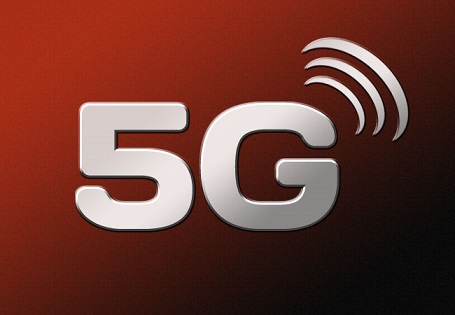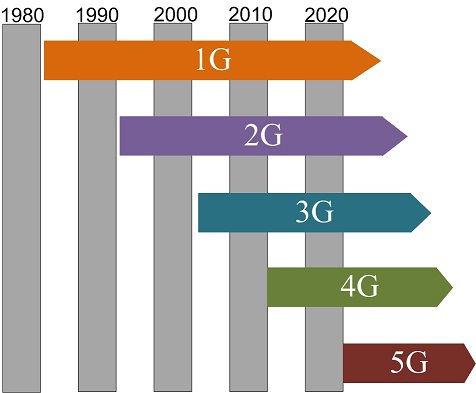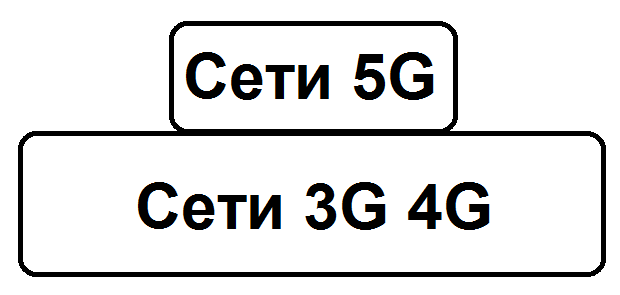5G networks: what is it?
Good day, habrovchane!
In this publication I will talk about the cellular networks of the future: how they will look, what to expect.
So, let's begin.
')

What is 5G in general? This is the future standard of mobile networks, which will lead them to a completely different level. Smart uncles from serious companies say that the networks of the fifth generation will appear around 2020. Why exactly in 2020? Now we will understand.

The figure shows the time of appearance of networks of already existing generations. It can be seen that the difference between every two generations is approximately 10 years. It is easy to conclude that the 5G network can thus be expected around 2020.
What are the fundamental differences between the networks of the fifth and previous generations? The first and most obvious is the increase in speed (at least an order of magnitude), reduction of delays, a significant increase in network capacity, which is necessary to meet the ever-growing demand for the Internet. The trend is that in the future everything will be connected to the network: from a variety of sensors to cars.
The second point is to highlight the transition to the network model, where the main is the subscriber, not the base station. In existing networks, the subscriber has to adapt himself to the network: the signal is too weak - move. Fifth generation networks will use smart antennas capable of changing the radiation pattern depending on the needs of subscribers in specific conditions. For example, if one subscriber is serviced in a cell at a given time, the data for it will go through a narrow channel, which will increase the signal-to-noise ratio and will increase the data transfer rate.
The third point is the transition to the region of millimeter waves. The spectral resource is limited and it is extremely difficult to find the necessary frequencies in the ranges traditional for mobile communication. Naturally, a significant increase in the data transfer rate will require much larger frequency ranges. The logical way out of this situation is the transition to a dozen GHz. Many people know that with an increase in the operating frequency, the communication range rapidly decreases, that is, the size of a cell. Therefore, we can conclude from the third point: the fifth generation networks will be used in places where there is a demand for high-speed data transfer. Full coverage is not expected.
The next item is to highlight such technology as MIMO. Its essence is to use multiple antennas on the transmitting and receiving sides. This technology has appeared in the specifications relating to the third generation. In most networks, LTE MIMO operates in 2x2 mode, that is, two antennas for transmission, two for reception. What are the advantages of this technology? In the 2x2 mode, data is transmitted via two independent channels at once, which makes it possible to increase the transmission speed almost twice. At the moment there are smartphones that support 4x4 mode. Unfortunately, it is impossible to increase the number of antennas to infinity due to the small size of smartphones. Another problem is the need to transfer service signals from each antenna, which reduces the efficiency of the technology.
The fifth point is to cancel the possible implementation of the device-to-device technology. There are frequent cases when subscribers communicate being tens of meters from each other. Thanks to the use of this technology, only the signaling traffic will be passed through the operator’s network, which allows to charge such calls, and the data itself will pass directly between the devices. This is the essence of technology.
What will the future network look like? 5G networks will be used in places where there is a demand for high-speed Internet, in cities. For general coverage will be used by networks of previous generations. If to present schematically, it will look like this:

Over the fifth generation of networks is working around the world, but Europe is the locomotive. The funds allocated by the EU for development are not comparable with those allocated in the rest of the world. According to the developers' plans, by the end of 2015, the requirements for the fifth generation standard should be formed. Up to this point, all the talk about speeds and other network parameters are just speculation.
Anticipating comments, “why do we need such speeds, 3G is enough for me”, I note that global changes in mobile networks are expected in the future. The number of devices connected to the network in the mode “always online” will grow rapidly. It is quite possible scenario when the television will go to mobile networks. There will be a kind of boom that occurred with the advent of data transmission in cellular networks.
In this publication I will talk about the cellular networks of the future: how they will look, what to expect.
So, let's begin.
')

What is 5G in general? This is the future standard of mobile networks, which will lead them to a completely different level. Smart uncles from serious companies say that the networks of the fifth generation will appear around 2020. Why exactly in 2020? Now we will understand.

The figure shows the time of appearance of networks of already existing generations. It can be seen that the difference between every two generations is approximately 10 years. It is easy to conclude that the 5G network can thus be expected around 2020.
What are the fundamental differences between the networks of the fifth and previous generations? The first and most obvious is the increase in speed (at least an order of magnitude), reduction of delays, a significant increase in network capacity, which is necessary to meet the ever-growing demand for the Internet. The trend is that in the future everything will be connected to the network: from a variety of sensors to cars.
The second point is to highlight the transition to the network model, where the main is the subscriber, not the base station. In existing networks, the subscriber has to adapt himself to the network: the signal is too weak - move. Fifth generation networks will use smart antennas capable of changing the radiation pattern depending on the needs of subscribers in specific conditions. For example, if one subscriber is serviced in a cell at a given time, the data for it will go through a narrow channel, which will increase the signal-to-noise ratio and will increase the data transfer rate.
The third point is the transition to the region of millimeter waves. The spectral resource is limited and it is extremely difficult to find the necessary frequencies in the ranges traditional for mobile communication. Naturally, a significant increase in the data transfer rate will require much larger frequency ranges. The logical way out of this situation is the transition to a dozen GHz. Many people know that with an increase in the operating frequency, the communication range rapidly decreases, that is, the size of a cell. Therefore, we can conclude from the third point: the fifth generation networks will be used in places where there is a demand for high-speed data transfer. Full coverage is not expected.
The next item is to highlight such technology as MIMO. Its essence is to use multiple antennas on the transmitting and receiving sides. This technology has appeared in the specifications relating to the third generation. In most networks, LTE MIMO operates in 2x2 mode, that is, two antennas for transmission, two for reception. What are the advantages of this technology? In the 2x2 mode, data is transmitted via two independent channels at once, which makes it possible to increase the transmission speed almost twice. At the moment there are smartphones that support 4x4 mode. Unfortunately, it is impossible to increase the number of antennas to infinity due to the small size of smartphones. Another problem is the need to transfer service signals from each antenna, which reduces the efficiency of the technology.
The fifth point is to cancel the possible implementation of the device-to-device technology. There are frequent cases when subscribers communicate being tens of meters from each other. Thanks to the use of this technology, only the signaling traffic will be passed through the operator’s network, which allows to charge such calls, and the data itself will pass directly between the devices. This is the essence of technology.
What will the future network look like? 5G networks will be used in places where there is a demand for high-speed Internet, in cities. For general coverage will be used by networks of previous generations. If to present schematically, it will look like this:

Over the fifth generation of networks is working around the world, but Europe is the locomotive. The funds allocated by the EU for development are not comparable with those allocated in the rest of the world. According to the developers' plans, by the end of 2015, the requirements for the fifth generation standard should be formed. Up to this point, all the talk about speeds and other network parameters are just speculation.
Anticipating comments, “why do we need such speeds, 3G is enough for me”, I note that global changes in mobile networks are expected in the future. The number of devices connected to the network in the mode “always online” will grow rapidly. It is quite possible scenario when the television will go to mobile networks. There will be a kind of boom that occurred with the advent of data transmission in cellular networks.
Source: https://habr.com/ru/post/243525/
All Articles